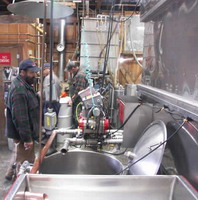

Mundus Trade & Finance Group |
|
Sugar Refining |
|
Refined sugar is the most popular and well known sugar in the developed world. Everybody
The process by which sugar is refined is very interesting. After all, sugar starts off in life as a piece of cane, or perhaps even a beet, and when the brown raw sugar juice is first extracted from the cane or beet, it hardly seems likely that the sparkling white crystals that are spooned over cereals and into cups of coffee in millions of homes the world over could have originated from such an unlikely place.
There are many ways to refine sugar, though the different processes used in refineries across the globe normally follow a series of basic steps. In no particular order, these steps are boiling, centrifuging or affination, crystallization, and carbonization. These steps are generally combined in a variety of different ways to purify sugar, remove the unwanted coloration, and produce high quality sugar that is suitable for human consumption.
The typical sugar refining sequence goes thus: boiling, centrifuging, carbonization, boiling, crystallization, and finally centrifuging once more. This is far from being set in stone however, much like the old adage about skinning a cat, there is more than one way to refine sugar. Some refineries may repeat one step several times, but miss others out completely, such as in the Russian ‘one strike’ refining technique, which involves no centrifugal stage whatsoever, but a much more intensive carbonization stage which uses a great deal of milk of lime to remove impurities. A typical generic refining process is outlined here in order to explain the various stages in greater detail.
As has been mentioned, sugar starts life as either sugar beet or sugar cane. It makes no difference to the final product whether sugar is extracted from beet or cane, and which is used generally depends on the climate in which the sugar is being produced. Sugar cane does better in tropical and subtropical climates, whereas sugar beet can withstand colder conditions. In either case, the sucrose needs to be extracted from the plant in order to make sugar. Sugar cane is relatively simple to extract sucrose from, as it has a high moisture level, and shredding and crushing the cane results in sucrose rich juice pouring out. Sugar beets, which are less popular than sugar cane as a source of sugar, but which can grow in conditions that sugar cane would die in, as for instance in the icy Russian climate, require a little more processing. Sugar beets are normally washed and thinly sliced, then placed into a hot water diffuser, where, like thousands of little tea bags, they are subjected to flowing hot water which leeches the sucrose out of the flesh of the beet.
In the case of refining sugar from sugar cane, once the raw juice has been extracted it is necessary to process it to extract the sucrose from the raw brown juice. In some cases the juice may first be boiled to reduce water content, or strained to remove any large particles of cane or beet which have snuck through into the juice.
Raw sugar is produced by evaporating the water away, leaving a thick brown mass of sugar which can contain a great deal of bacteria and other contaminants.
In order to refine it into ICUMSA 45 sugar, it must undergo several stages of refining. In the first of these, a process known as ‘affination’, the raw sugar is mixed with a thick, high sucrose liquid. The mixing of the sucrose liquid and the raw sugar creates a substance called “magma”. This magma is then sent into a centrifugal chamber and spun at high speed. Spinning the magma in this way separates the solid crystal parts of the sugar out from the brown liquid, which is known as molasses.
An alternative to this procedure is not to evaporate the water from the raw sugar juice but to simply boil it, allow it to crystallize, and then centrifuge it to remove the sugar. The sugar that emerges from this process is VHP sugar, a raw sugar with a very high sucrose content which can then be sent straight to the carbonization or phosphation stages of refining.
During production of VHP sugar, the liquid that driven off from the sugar in the first centrifugal process is known as first molasses. This will be boiled and centrifuged again to produce second molasses, and then once more to produce third molasses, otherwise known as blackstrap molasses. The sugar from these two centrifugal stages is dissolved in water and then centrifuged once more to create more VHP sugar. VHP sugar was originally a product of Brazil, and it is still Brazil’s most plentiful sugar export.
In some mills, especially Brazilian mills, this is all the processing that the sugar will undergo. VHP sugar is then sent off to other refineries, generally in other countries.
Whether a refinery is working with imported VHP sugar, or whether it has taken raw sugar and partially purified it through affination, it is necessary to remove the coloration and microscopic contaminants that are still present in the sugar.
This is achieved by a process called carbonization, which involves dissolving the sugar crystals in to a solution that is 50% sugar and 50% liquid. Milk of lime is then added to this solution, and as it travels through the solution it forms calcium carbonate deposits which attract impurities and lock them away inside the deposits. The calcium carbonate settles at the bottom of the tank and is separated from the solution which is now entirely sucrose and water. An alternative to this process involves the use of phosphorous, which performs a very similar function, cleaning out impurities and leaving only sucrose in the liquid solution. If phosphorous is used, this stage is usually known as phosphation.
Once the decontamination and decolorization stage is finished, it is time to remove the water and let sugar crystals grow. In order to achieve this, the sucrose and water solution is boiled to remove the excess water, and sugar dust is sprinkled into the concentrated solution to encourage the growth of sucrose crystals. Once grown, the crystals are once more spun in the centrifugal chamber to remove the remaining liquid.
Et voila. The final product is highly refined sugar, free from contaminants and ready to be packaged and shipped to supermarkets for consumers to purchase, or to manufacturers who will use it in foodstuffs. |


